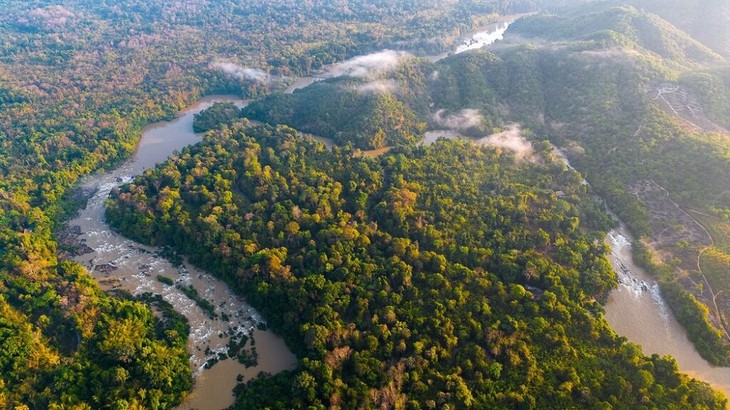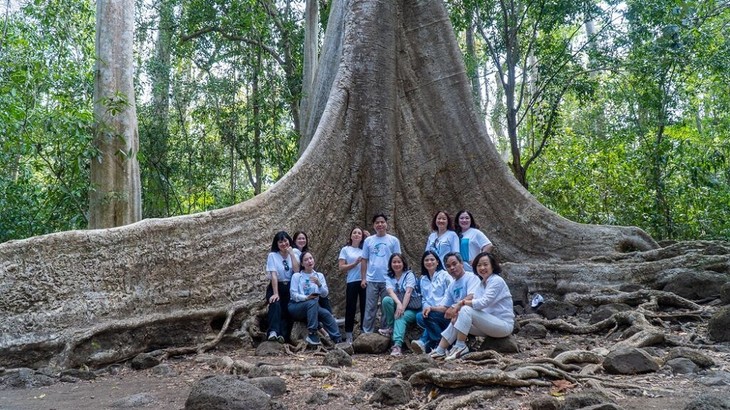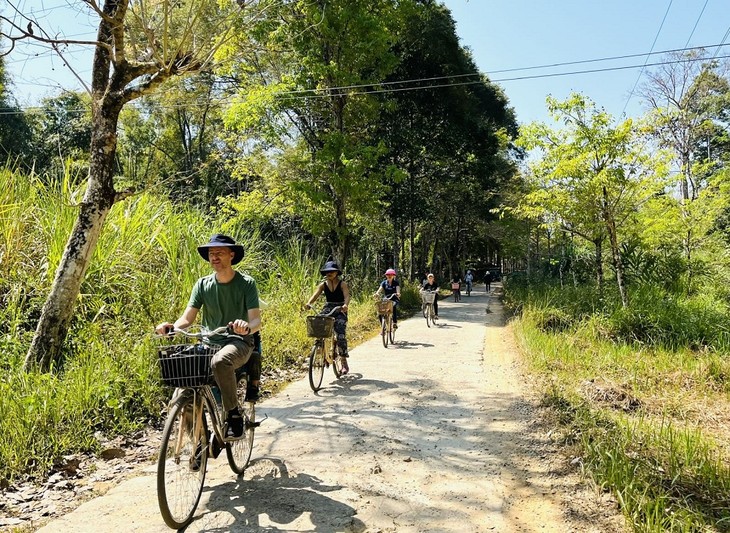(VOVWORLD) - In late June, Cat Tien National Park was the first national park in Vietnam received Green List status of the International Union for Conservation of Nature (IUCN). This is a recognition for Cat Tien’s biodiversity conservation efforts.
 A bird-eye view of Cat Tien National Park (Photo: Hoa Anh) A bird-eye view of Cat Tien National Park (Photo: Hoa Anh) |
Cat Tien National Park in the southern province of Lam Dong is a standard sample of tropical forest ecosystem of the Southeast region. It covers an area of more than 82,000 hectares spanning three provinces – Dong Nai, Lam Dong, and Binh Phuoc.
Cat Tien is home to 1,730 species of animals and 1,655 species of plants. The forest has an important function in creating the ecosystems, preserving biodiversity, and playing a great role in generating livelihoods for people living in the buffer zone.
Cat Tien National Park has more than 340 species of birds, accounting for more than 40% of Vietnam's bird species. While trekking in the forest, visitors can encounter rare birds and primate species such as black-shanked or brown-shanked douc langurs, yellow-cheeked black gibbons, and wild oxen.
Le Duc Khanh, a staff of the Cat Tien National Park, said: “The wild oxen usually live in herds of at least three to 12. It will take you a long time to spot an ox. Visitors can climb up a high hut to have a panoramic view. The most possible time to see the wild oxen is at the beginning of the rainy season, because young grass sprouts well. It’s the favorite food of the wild oxen.”
 The 400-year-old "tung" tree in Cat Tien National Park (Photo: Hoa Anh) The 400-year-old "tung" tree in Cat Tien National Park (Photo: Hoa Anh) |
Another famous attraction in the National Park is the 400-year-old “tung” tree, which is more than 40 meters high. The tree trunk diameter is up to 1 meter, while its roots crawl largely and hugely on the ground. There are plenty of “tung” trees and hundreds of years old banyan trees growing scattered in the forest. A newly-opened Flora and Fauna Museum displays many artifacts and specimens for visitors to study.
Being a natural ecosystem reservation, the National Park houses the Bear and Wildcat Rescue Station. This is a semi-wild environment for animals rescued from illegally caged farms, such as bears, monkeys, and rare birds. The Park has implemented projects to restore biodiversity, habitats, and species.
Researcher Pham Ngoc Duong, a staff of the Cat Tien National Park, said: “Our study finds 400 species of big mushroom in the Cat Tien National Park. 50 species have been studied and confirmed as edible and having medicinal values. We have built 15 mushroom growing models from natural mushroom varieties. Many varieties of mushroom are being grown in research area. We have also established models for technology transfer.”
The National Park is an ideal destination for tourists to mingle with peaceful nature and explore flora and fauna. Every year Cat Tien National Park welcomes 55,000 to 65,000 domestic and foreign visitors and researchers.
A tourist from Ha Noi, Pham An, said: “Cat Tien has primeval forests and flooded forests with many rare animals. I’ve been to Cuc Phuong national forest in Ninh Binh province and now I am here. It’s a very impressive and interesting place. The air is fresh and cool.”
 Tourists cycle to explore Cat Tien National Park. (Photo: Bao Tin Tuc) Tourists cycle to explore Cat Tien National Park. (Photo: Bao Tin Tuc) |
From the Cat Tien’s Management Center, tourists can join a tour to travel 20 km by car then trek 5 km in the forest to Bau Sau to explore the deep forest. Tran Van Binh, Director of the Center of Environmental Education and Services of the Cat Tien National Park, said: “The special-use forest of the Cat Tien National Park has a number of unique features that are not found in other places. We organize tours to watch animals in the wild during the day. In the early morning, tourists can see primates. The Bau Sau Ramsar site is an exciting wetland place for visitors to experience.”
Environmental education programs for local residents and tourists have been held to raise public awareness of protecting natural resources, which will create opportunities for their sustainable livelihoods. Pham Van Thinh, Director of the Cat Tien National Park, said: “This is a tool for us to oversee and evaluate our activities. It measures all biodiversity activities from now to the future.”
Cat Tien was recognized by UNESCO as a World Biosphere Reserve in 2001. It was listed as Vietnam’s Special National Relic in 2005.